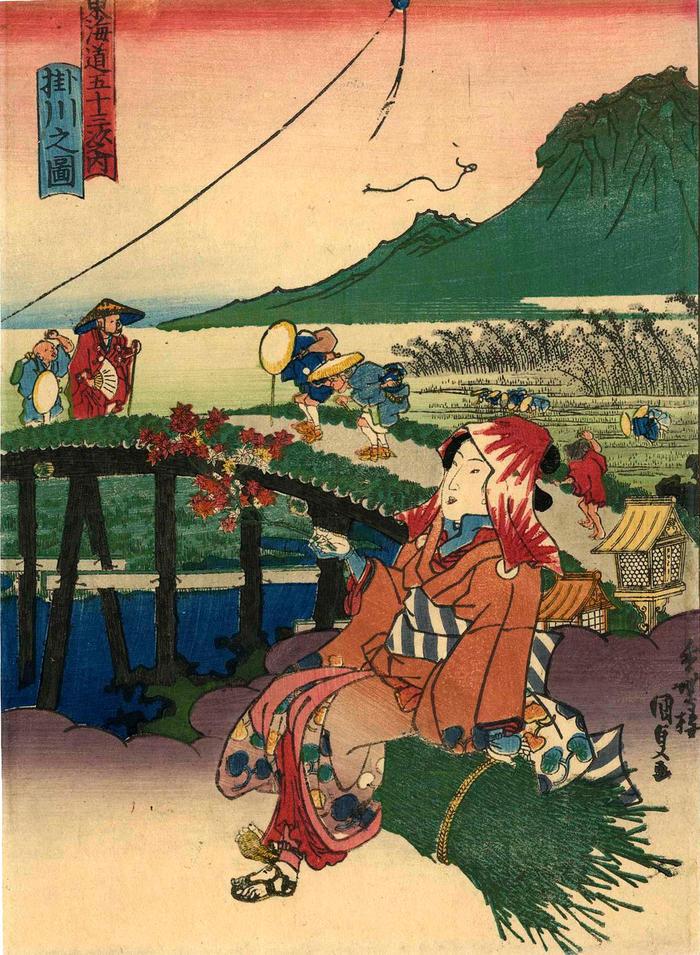Utagawa Kunisada (歌川国貞) / Toyokuni III (三代豊国) (artist 1786 – 01/12/1865)
View of Kakegawa (Kakegawa no zu: 掛川之図) from the series Fifty-three Stations of the Tōkaidō Road (Tōkaidō gojūsan tsugi no uchi: 東海道五十三次之内)
ca 1838
Signed: Kōchōrō Kunisada ga (香蝶楼国貞画)
Museum of Fine Arts, Boston - published by Moriya Jihei
Museum of Fine Arts, Boston - published by Moriya Jihei, but a different version
National Diet Library - published by Moriya Jihei and Sanoya Kihei
Spencer Museum of Art - published by Moriya Jihei
Museum für angewandte Kunst, Vienna
British Museum - Hiroshige's version
Virginia Museum of Fine Art
Ishikawa Prefectural Museum of Art - they date their copy to 1836
Bryn Mawr
Honolulu Museum of Art - published by Moriya Jihei
Berkeley Art Museum and Pacific Film Archive, the University of California
Carnegie Museum of Art - published by Moriya Jihei
Fujisawa Ukiyo-e Museum
Victoria and Albert Museum
Nelson-Atkins Museum of Art All of the prints in this series are chūban sized. The example of this print in the collection of the Museum of Fine Arts in Boston is 9 13/16 x 7 1/4 in. This one in the Lyon Collection is fractionally smaller because it has been trimmed slightly at the top and along the right hand side.
****
This print is number 27 in the series. The curatorial files at the Museum für angewandte Kunst in Vienna say: "The representation resembles the template by Hiroshige down to the last detail. In the foreground is a woman sitting on a bundle of sticks. She wears a pink kimono with long sleeves (furisode), which shows a pattern of different colored mallow leaves on the sleeve ends and on the hem. She wears handguards on her hands, which protects you from the sun during physical work. She is probably on her way to the market to sell the bundle of sticks. Over her head she wears a cloth (tenugui 手 拭) that has been dyed using the shibori technique 絞 in 染 め. Simple straw sandals on the feet. In her hand she is holding a branch with discolored maple leaves (momiji)."
Gian Carlo Calza in his description in Hiroshige: The Master of Nature of the original Hiroshige print re-imagined in this scene said: "There is a strong wind and a couple of elderly wayfarers are struggling to get over the crest of the bridge. The child behind them, dressed in a light garment with a starfish motif, is having fun aping them. [Not visible in the Kunisada print because of the seated woman, but her scarf mimics the fabric of the child which is not seen.] Two men are crossing the bridge from the other direction: an aged ascetic hermit from the mountains (yamabushi) followed by a young disciple wiping the sweat from his brow and calling out anxiously. The hermit continues unperturbed, holding an open fan as a sublime symbol of indifference to adversity, an almost imperceptible smile playing about his face.
Someone is flying a kite high overhead; another has lost his, which flies off in the direction of Mount Akiba in the distance, the location of a Shinto shrine of he same name. Just across the Shioi River, we see peasant women transplanting young rice shoots into a paddy."
Mt. Akiba is about 885 meters high or about 2,903'.
****
In Tokaido Landscapes: The Path from Hiroshige to Contemporary Artists, 2011, #27, p. 39, speaking of the original Hiroshige print it says in a text by Sasaki Moritoshi: "In the foreground, night lanterns for the deity Akiba Gongen can be seen and Mount Akiba appears in the distance. Kites are flying in the cloudless sky. The flying of Enshū Yokosuka kites was a local attraction in Kakegawa, and it normally took place around May 5 on the lunar calendar. The sight of people planting rice in the paddies enhances the sense of spring. The two travelers on the bridge, who appear to be a couple, bow to the approaching elderly priest. The chance, momentary encounters of travel is the theme of the drawing. The barefoot child and the young priest bringing up the read add a touch of humor to the scene."
****
In Hiroshige: l'art du voyage, Paris, 2012, p. 76 it says: "Cette estampe représente le pont Ōike sur la Futase, comme on appelle cette partie du fleuve Onga."
****
Muneshige Narazaki in Masterworks of Ukiyo-e: Hiroshige, the 53 Stations of the Tōkaidō (p. 56) noted that the bridge is earth-covered over the Shioi River. "In the background rises Mount Akiba, at whose summit is the Akiba Shrine, one of the oldest in Japan."
****
Illustrated:
1) in a small color reproduction in Kunisada's Tokaido: Riddles in Japanese Woodblock Prints by Andreas Marks, Hotei Publishing, 2013, page 69, T24-27.
2) in two color reproductions representing two editions in Japanese Kite Prints: Selections from the Skinner Collection by John Stevenson, the Drachen Foundation, 2004, #24, page 71, text page 70.
Stevenson wrote: "Hiroshige and Kunisada knew each other well. Kunisada was famous for his figure drawing; Hiroshige specialized in landscape prints. Recognizing their separate talents, publishers sometimes commissioned series in which Kunisada drew the figures and Hiroshige drew the backgrounds. Here Kunisada has borrowed outright the designs of Hiroshige's Tōkaidō series as backgrounds for a series of bijin-e, pictures of beautiful women. His audience would have immediately recognized the source of the backgrounds, landscapes issued just a few years before; there would have been no thought that Kunisada was passing off the background designs as his own."
"A seller of charcoal and firewood rests on her load, a branch of red maple leaves in her hand. She wears a tie-dyed headcloth and unrealistically fine robes, like Hokusai's Oharame... Hiroshige's original design of Kakegawa was horizontal; Kunisada has compressed this into a vertical format, using most of the elements successfully, although the gaze of the boy no longer matches the disappearing kite."
landscape prints (fūkeiga 風景画) (genre)
beautiful woman picture (bijin-ga - 美人画) (genre)
